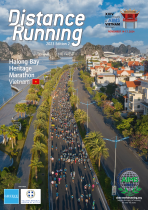Sport science
29 June 2020, 7am
How far did you go, really?
For distance runners across the globe the COVID 19 lockdown has wrought havoc on their running routines.
Cancelled races or only being allowed to run solo is the least of it. In some countries allowance is made for daily exercise but in others exercise has either been banned or restricted to the immediate surrounds of the home.
The result has been the rise of the lockdown marathon. It may have started with French runner Elisha Nochomovitz who, having been prevented from running the Paris Marathon after its six-month postponement, ran the length of a marathon on his 7m balcony.
In South Africa, where exercise outside the home was completely banned, runners signed up pledging to run 2km per day in order to cover a marathon distance by the end of the period of lockdown (or an ultra-marathon, should it be extended).
In Tokyo’s western suburbs 25-year-old Goshi Osada spent 54 hours and 40 minutes running 10,667 laps of a 15m trail he had marked out around a tree with a 1m difference between its highest and lowest points. He covered 100 miles (just over 160km), and climbed higher than Mount Everest and back down en route.
Keeping count of thousands of laps must have been difficult, especially for runners who admitted to becoming dizzy and light-headed at times. If they hadn’t carefully measured the length of the lap and kept an accurate count of laps run there would have been no way to calculate the distance because running wearables under these conditions are just not accurate.
Take the ‘balcony marathon’ and look at the sheer insanity of the record that Elisha got from his wearable and posted on Strava. If we were to believe the data then his balcony is a few hundred metres wide, spans several highways and includes elevation changes of over 20 vertical metres.
Colin Harper, a veteran of the Marathon des Sables, had carefully measured out a course in his back garden so as to run an accurate marathon, only to discover that his sports watch had recorded him as running a full 10km short.
“As you can see [the satellite trace] struggled to keep track of me,” said Harper. “And as a result underestimated the distance by quite a bit. I’m quite sure that I ran at least 26.2 miles.”
Beyond the frustrations and indignity of having your distance incorrectly recorded accurate positioning really matters both for training and on race day.
The ability to run at a constant pace is a foundation of training but without an accurate record of distance travelled wearables are reduced to guesswork.
For Lars Rasmussen, one of the co-founders of what became Google Maps, it’s all about planning and performance. He ran the NYRR Staten Island half marathon last year. It was his first half marathon and he used his watch to get split time audio cues during the run.
“I wanted to break two hours and maintained an average pace of nine minutes per mile throughout the first 12 miles according to my app. But then, a few minutes after the app told me I had hit 12.5, I noticed the 12-mile marker on the course. Suddenly realising I had more than a mile left when I thought it was less than half that totally floored me mentally. I had to walk-run a fair bit of that last mile and failed to make the two-hour mark as a result.”
There’s also the issue with where you are in the world, especially for fell-runners, where it can become an issue of personal safety. Colin Harper said: “There are occasions when it is really important to be the right side of a hedge or ditch but the accuracy of GPS isn’t enough to indicate you are off-course by only a few metres. I have run several hundred metres on the wrong side of a hedge until the paths gradually diverged and I realised I was on the wrong one. I had no idea where I had missed the gap in the hedge, only that there was no way through where I was.”
Why are current fitness trackers so inaccurate? What’s really going on?
Running in confined spaces has shone a light on just how untrustworthy today’s wearables are in terms of reporting your location. Here’s why:
• Poor satellite reception/not enough satellites
By watching the films posted by Nochomovitz, we can see that his balcony has a limited view of the open sky. What that means is that when his sports wearable is trying to get “GPS ready”, i.e. to get a satellite fix, it only has a fraction of the available satellites to look at. With so few satellites to fix on, and all in the same region of the sky, his device would expect a margin of error around 60m – hence the trace thinking that he was flying superman-style over the highway across from his balcony.
• Poor sensor fusion
Take a look at the elevations reported on the Strava trace: apparently his balcony ranges from +13m to –19m in elevation. This is probably because of the poor GPS sky coverage and the barometer on his phone is getting confused by changes in temperature and pressure on the balcony – tricking it into thinking that he climbed the equivalent of 10 flights of stairs.
What can we do about it?
FocalPoint is a Cambridge-based start-up that has developed software upgrades for standard GPS chips to make them 10 times more accurate, especially in urban environments where signals get really messy.
Lockdown has created the constraints for FocalPoint’s engineers to test it in a similar way to the lockdown marathoners. Here’s a micro-version of Strava Art, running a heart-shaped trace in a 5×5m back garden. Here’s what it looks like on a major brand watch vs a Google Pixel equipped with FocalPoint D-Tail technology. Remember – this is run in a yard that is just 5m x 5m.
Trial the tech
The much higher integrity trace is created by using a machine-learning-driven human motion model to get a true picture of how runners move through space, together with precise sensor fusion to get a true reading of elevation.
Combine that with FocalPoint S-GPS technology, soon to be available in some consumer-grade smartphones, and runners can expect a fix that is ten times better..
FocalPoint tech is currently trialing a number of sports wearables, and is expected to be available in smartphones from 2021.
What can you do about it?
Runners interested in getting a more accurate measurement of their run can join the FocalPoint trialist community by filling out FocalPoint’s demo request form.







